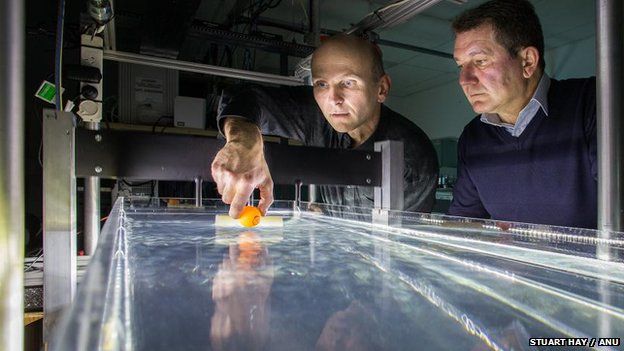Physicists make 'tractor beam' in water
- Published

Scientists in Australia have produced a "tractor beam" in a water tank.
They can control the movement of a floating ping-pong ball just by making a specific pattern of waves.
By changing the pattern, they moved the ball around the tank in various ways, including pulling it closer like the famous beam from science fiction.
The findings, published in the journal Nature Physics, have the potential to help contain oil spills or control and retrieve other floating debris.
"No one could have guessed this result," said Dr Horst Punzmann, who led the project at the Australian National University in Canberra.
"We have figured out a way of creating waves that can force a floating object to move against the direction of the wave."
Dr Punzmann and his colleagues used a very fast videocamera to record the water movements that resulted from a range of different shapes, plunged in and out of the water at various speeds.
They also covered the surface with floating tracer particles that allowed them to see the direction of currents on the water surface, which are distinct from the patterns of the waves themselves.
Bathtub science
Simply dropping a cylindrical wave-maker - a bit like a long rolling pin - in and out of the water, gently, produces a predictable set of waves undulating away from the disturbance. The current on the water surface also travels away from the middle of the cylinder.
But if the size of the up-and-down movement is increased, that wave pattern breaks up into choppier pulses. At the same time, the central current switches direction, so that something floating near the middle of the tank can be pulled back towards the wave-maker.
As well as this relatively simple "tractor beam" effect, the team created and modelled various other flow changes that meant they could effectively move a ping-pong ball around their tank at will.
"We can engineer surface flows of practically any shape," said Prof Michael Shats, the paper's senior author. "These could be vortices, these could be outward and inward jets - it's a variety of different flow configurations."
Prof Shats explained that his team started their tank experiments after they realised just how complicated the maths involved must be.
"We realised that particle motion on the surface, determined by waves, is far too complex to handle by any existing theory."
The researchers believe their discovery could be applied in open water. "The applications could be numerous," said Prof Shats said. "For example, collecting floating objects, manipulating small boats on the surface, or maybe collecting oil spills."
"It's one of the great unresolved problems, yet anyone in the bathtub can reproduce it," Dr Punzmann said. "We were very surprised no one had described it before."
Recreating the tractor beam at bath time could prove a rather exhausting challenge, however. The machine used in the lab created waves of precise heights at a rate of between 10 and 100 every second.
- Published5 June 2014
- Published30 May 2014
- Published6 November 2013